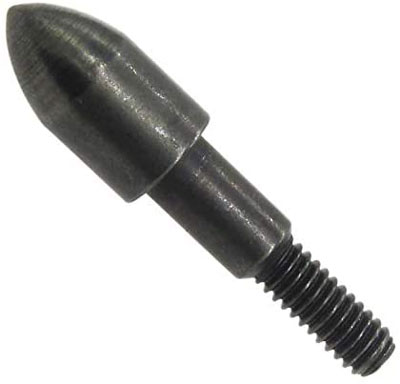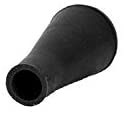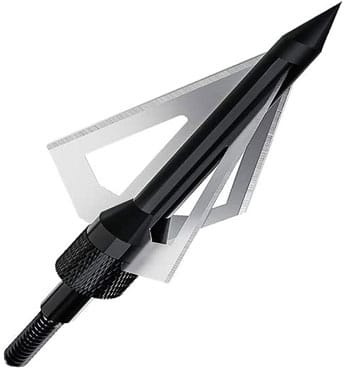
When first starting with archery, there are many different things to learn. With so many different pieces of gear, it can be a challenge to know where to get started. One of these pieces of gear is an arrow tip. Choosing the right type of arrow tips can seem almost overwhelming when first starting.
Each type of arrow tip will have its own unique characteristics and uses. It’s a good idea to figure out what kind of tip you’ll need, depending on its intended use. With so many different types of arrow tips, we can break them down into a few separate categories. These are practice points, small game tips, and big game (broadhead) tips.
While there is some overlap between these categories, each one is designed for different use. Some tips are strictly for practice, while others are designed for hunting specific animals. You must match the arrow tip with your intended activity for the best results. So what are all of the different types of arrow tips? Let’s go over each one and see which type may work best for you.
A wide variety of arrow tips can be found in the category of practice and small game tips. From target practice to hunting, many of these points can serve both purposes.

Bullet point arrow tips are a very popular and classic design that is used for practicing. They are called bullet points because of their traditional shape that resembles a bullet. Bullet tips are great for practicing as they significantly reduce the impact once they meet a target and they hold up extremely well.
Their large and curved shape makes them easy to remove from targets. This makes them an excellent choice for bag targets, foam targets, or even carpet or grass targets. These arrow tips can also be matched to be the exact weight of big game hunting broadheads. This allows you to practice with weight-matched target shooting points, all without making adjustments to your bow sight.

Target points are very similar to bullet points and serve the same basic purposes. The major difference between target points and bullet points is their shape. Target points have a short, cone-shaped design made for target practice. This makes them much more aerodynamic than bullet points and will give them more penetration into targets.
Just like bullet points, these are usually weighted to match a hunting broadhead and used for the practice among archery hunters. The deeper penetration and design, however, make target points more difficult to remove from targets than bullet or field tips.

Field points are one of the most common types of arrow tips out there. These are used for target practice and occasionally hunting smaller game. Their design features a precise point that flares into a wider shoulder up near the base. This special design allows the arrow to avoid sticking in the target and absorbs impact. Field tips are so popular because they offer much more precision and penetration than bullet and target points.

Combo points are a perfect mixture of both bullet and field tips. This design has a pronounced tip that features a gentler flare that broadens to a distinct should near its base. Combo points are made for target shooting and practice, although they can be used for hunting small game. 3D and target shooters commonly use these tips because they are very accurate thanks to their aerodynamic design. They are also easily removed from all types of targets.

For ultimate accuracy when shooting in competitions, many target archers will use pin points. These archery points are designed to have a straight, tapering angle from its tip. This gives them high penetration ability, even on tougher targets. This also allows these tips to puncture straight and deep. Pin points are usually only used in high accuracy competitions by high-level archers.

Bludgeon tips were designed for hunting small game. Instead of cutting or penetrating as most arrow tips, bludgeon tips use energy transference. Upon impact with an animal, these tips help deliver a giant impact and blunt force trauma.
With a flared head, they also do not penetrate at all. This also helps them from becoming hidden in brush or under grass. Bludgeon tips come in a large variety of different shapes and sizes. Some bludgeon tips even have the ability to slip over the top of regular field or practice point.

Blunt tips are essentially the same as bludgeon tips, although their design is a little different. These tips are a simple cylinder shape without any tapering or flaring. These tips are used for hunting small game like squirrels, rabbits, and small birds. Because of their simple design, they are not as popular as bludgeon tips although they function in the same way.

Bulge points look similar to bullet points except that they are wider in the center than the arrow shaft. They also function similar to bullet points and are primarily used for target practice. These points will hit a target hard and leave a big hole, although they do not penetrate very well. They are also somewhat difficult to remove from a target when retrieving arrows.

Judo points are another point used specifically for small game hunting. They are perfect for birds and squirrels where there is thick brush and tall grass. This is because these tips have small spring-like arms that are designed to catch brush and other objects. This keeps them from becoming lost when shooting at animals on the ground. One of the more unique archery points, judo points should be used with caution as the outreaching arms can catch and puncture other objects.
In addition to practice and small game tips, there is also a varsity of arrow tips that are designed for hunting large game. If you plan on hunting deer, elk, bear, or any other big animals, you will need to use one of these arrow tips. Broadheads are found in a few different varieties.

Fixed blade broadheads are the most common and traditional style of hunting tips. These broadheads are of an older style and most commonly seen used with traditional bows. These heads range in blade numbers from 2 to 6 and have a wide range of diameters. There are no moving parts and everything is fixed in place (hence the name). Because of this, they are very strong and reliable. While they are not as accurate when fired at higher speeds, they are otherwise a very trusted and reliable option.

Removable blade broadheads are very similar to fixed-blade heads. They have no moving parts and are very solid and reliable. The big difference between the two is that the blades can be removed and changed out. This gives an archer the ability to easily change out blades without changing the whole broadhead. However, the bases will still need to be changed out if damaged. These broadheads are one of the most popular options for hunters today.

Mechanical broadheads are the newest style of broadhead. These feature a set of hidden blades that stay tucked away during flight. Upon impact, the blades are designed to open and expand in diameter. This gives them much more accuracy during flight because there is minimal wind friction. Upon impact, they generally have a much larger cutting diameter because they expand.
These broadheads require much more power and energy to effectively penetrate its target, so do keep this in mind. They are also subject to mechanical failure if not well cared for. Mechanical broadheads are best suited for bowhunters looking to increase cutting diameter, shooting modern compound bows with increased speed and accuracy.
As you can see, there are many different types of arrow tips. In order to ensure that you are using the right one, you must consider its purpose. Will you be target shooting or hunting? The answer might help you to decide on which arrow tips will work best for you!